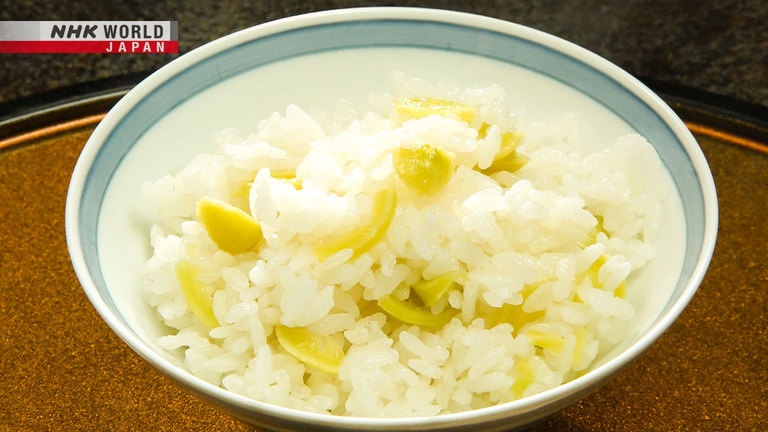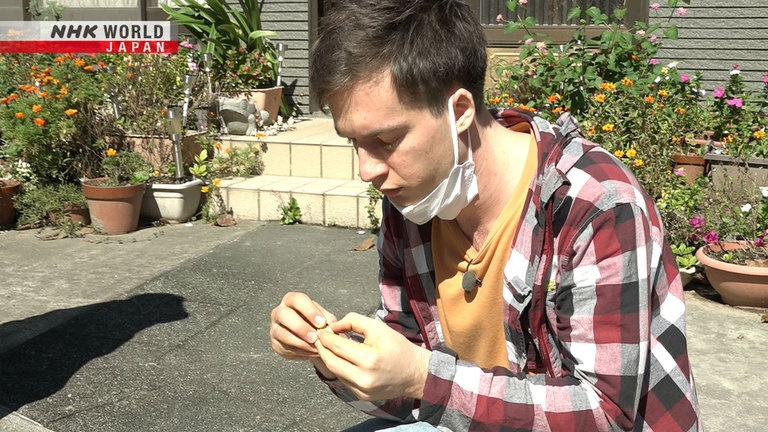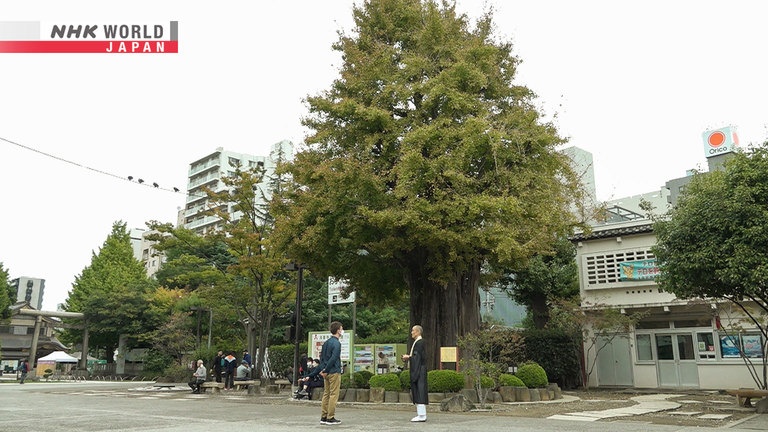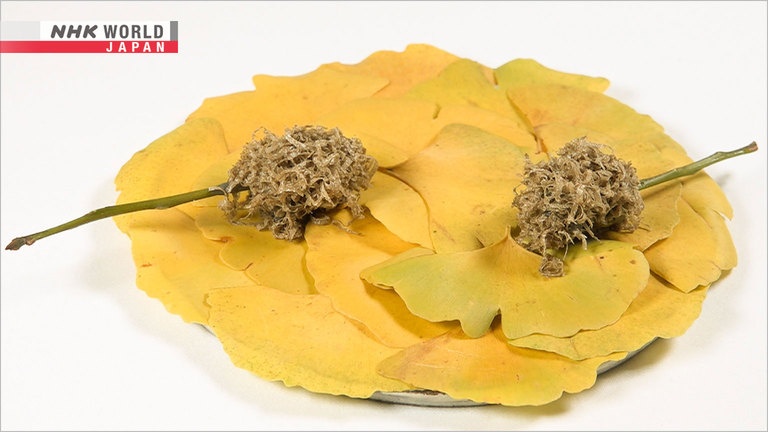GINKGO NUTS
Darwin called ginkgo trees living fossils. In fall, they offer a fun splash of yellow to the colorful landscape. Today, we focus on their nuts! The outer shell may smell a bit funny, but inside is nothing but great flavor. Harvest ginkgo nuts from 10,000 trees at a famous production site and chow down with local farmers. Feast your eyes on traditional recipes, and discover how the nut is paired with champagne at a French restaurant in Tokyo. (Reporter: Zack Bullish)




Transcript
Tokyo: This world-class metropolis is a veritable gourmet wonderland.
Discover the stories behind the ingredients that make this city so delicious - so "oishii."
In fall, ginkgo trees paint the city in gold.
This time, we look at their hidden charm - ginkgo nuts.
The outer layer has a funky smell that you may find unpleasant.
But crack it open - you'll find nothing but flavor!
A gem that adds eye-popping color to any dish.
Discover the power and wisdom inside this gem of a nut as we look back on its history.
Visit a town of 10,000 ginkgo trees.
But bring a helmet!
This is scary!
Check out a new wave of ginkgo cuisine.
Endless possibilities hide within a truly underrated nut.
Trails to Oishii Tokyo.
Hi, I'm Zack Bullish.
Check out this long stretch of ginkgo trees.
They're so many here in Tokyo that ginkgo's the official tree of Tokyo.
This program is on the seed in side of the fruit of this tree - the ginkgo nut.
I hadn't tried this delicacy prior to coming to Japan, and never imagined there was any edible part of a fruit with such a pungent stench.
Surely, I'm not the only one the ginkgo fruit's odor's been fooling.
Let's unveil the tasty mystery within this smelly fruit.
So, where's ginkgo from?
A restaurant in Ginza, Tokyo, offers a clue.
It's a Cantonese restaurant.
Here's ginkgo.
Porridge?
Ginkgo nut porridge?
It's their signature dish.
Be careful, the pot is hot!
Wow, nice aroma.
Quite appetizing.
"Itadakimasu!"
Very smooth.
It melts in your mouth.
Easy to eat.
The nut flavor fills the soup.
"Oishii!"
I could eat this for breakfast every day.
Me too.
Is there a long tradition of
ginkgo porridge in Guangdong?
Yes. This is my great-grandmother's recipe.
Ginkgo nuts and bean curd
have to go in porridge together.
It's got rice, dried bean curd, dried scallops, and ginkgo nuts.
Koyama is from Guangdong Province, China.
The porridge was a big part of her childhood.
She couldn't have a restaurant in Tokyo without putting it on the menu.
But it isn't easy to make.
It's a two-day process - the nuts need to be simmered with dried ingredients and rice.
The result is a tasty dish that's also very healthy.
Ginkgo nuts warm the lungs,
and reduce phlegm and coughs.
Drier air in fall makes you cough,
so it's a good time to eat ginkgo nuts.
It's a powerful food.
It really is.
Ginkgo porridge - packed with a family's tender love and care.
Coined a "living fossil" by Darwin, the ginkgo tree has been around for over 200 million years.
They used to grow all over the world, but only one species thought to originate in China remains today.
Ginkgo appears in several Chinese medical documents, revealing ancient use as an herbal medicine.
When eaten warm, ginkgo nuts soothe
the lungs, increase strength, reduce
coughs, and control the bladder.
It isn't clear when the tree came to Japan, but it grows all over the country.
Zack heads to Senso-ji Temple in Asakusa to find out more.
- Here it is.
- What a large tree.
This is the sacred tree of Senso-ji.
They say it releases moisture
to protect itself from fire.
And that protects surrounding buildings.
You often see ginkgo trees planted
around temples and shrines.
Senso-ji has many as well, maybe
because they're seen as protectors.
The main hall, main gate, and five-story pagoda
survived the 1923 earthquake.
But most of the Asakusa area burned down.
The tree may have stopped the fire from
reaching the kannon statue in the main hall.
Very surprising.
You'd think a tree would burn as well.
Later, the main hall was destroyed in the 1945 bombing of Tokyo.
The ginkgo tree suffered the same fate.
But it grew back and protects the temple and surrounding area to this day.
Ginkgo trees have a lot of moisture, so they don't burn easily.
This may explain why they've come to be so prominent around Japan.
People fell deeper in love with the nut's flavor.
Zack heads to a traditional spot to try some.
They mainly serve skewers and kamameshi rice, but they don't come with ginkgo nuts.
Zack finds what he's looking for on the wall.
Salt-roasted ginkgo nuts - a fall delicacy.
Ginkgo nuts.
Looks like they're covered with snow.
- Is that salt?
- Yes.
- Must be salty.
- The inside isn't.
- You take off the shell?
- Right.
- I don't eat them as-is?
- Too hard to eat.
I see.
Here we go.
How nice!
That's their usual color?
I'll put some salt on it.
It's considered a nut,
but it has a gummy texture.
It's a unique texture.
Right. There's nothing quite like it.
It has a nutty aroma.
Like a chestnut or walnut.
It's a bit bitter too.
"Oishii!"
There are a few different ways to make this.
Here, lots of salt is put in water.
Toss in some cracked nuts.
Boil them over high heat.
Salt sticks as water evaporates.
Coated in salt, they're good to go.
It's a popular snack with alcohol.
Enjoying them with sake while waiting for the main course is a highlight of the fall season.
These two are all I need.
Aichi is a top area for ginkgo nut production.
A town called Sobue is at the core.
In fall, the area is painted yellow.
Home to around 10,000 ginkgo trees, the town is known for strong winds coming from the north.
It's said the trees were planted to prevent fires from spreading.
Once people realized how tasty the nuts were, commercial farming also took off, about 100 years ago.
There's some.
Ginkgo trees line the streets.
Some are raised to be shorter with wider branches, for an easier harvest.
The Tomita family has big trees.
Hello. Mr. Tomita?
Nice to meet you. Lovely trees.
- This is 190 years old.
- That old?
My fourth great-grandfather planted it.
The Kyuju variety started here.
Some of the ginkgo branches in the area were replaced with those from this tree to help them grow more nuts.
That boosted ginkgo nut production and solidified the town's reputation as ginkgo nut land.
It still produces a lot of nuts.
150 kg, not including the outer layer.
150 kg of nuts a year?
That's a lot.
I send them to high-end restaurants
in Kyoto, Osaka, and Tokyo.
It's mid-October.
The leaves haven't turned yellow, but it's peak season for nuts.
I can use a stepladder early on.
At this point, I have to use
a long pole with a hook.
There are three sizes, the longest
being about 7 meters.
That's long.
These up here are ready.
- Try shaking them down.
- May I?
- Some fell.
- Keep pulling.
This seems dangerous.
- The nuts are pretty hard.
- They'll hurt your head.
I'll duck.
Ouch!
This must get tiring.
Ow!
But not all ginkgo trees have nuts - only the female trees do!
In fact, their ecology is a bit of a mystery.
Remember, the town has around 10,000 ginkgo trees.
But only about 100 of them are male!
Male trees sprout flowers in April.
Wind carries their pollen across a wide area until it lands on female flowers.
Once it settles down, a five-month process begins.
Finally, sperm is formed.
They swim to eggs inside the female flowers, where fertilization takes place.
It's an example of ancient ecology - the ginkgo tree is truly a living fossil!
After harvest, the outer layers are removed.
We'll use this machine?
There's a propeller inside.
It takes off the outer layers.
- Those are ginkgo nuts?
- Yes.
Juice is dripping from the bottom.
- The juice and outer layers are separated.
- From the nuts?
It's giving off a strong scent.
Very unique aroma.
Doesn't the smell bother you?
I'm used to it.
We live with this stench every day.
Do you always work together?
It's a two-person job.
The odor comes from the outer layer.
While unpleasant to many humans, dinosaurs were likely attracted to it.
They may have played a big part in spreading ginkgo seeds around.
He's been at work for about an hour.
That surprised me.
The outer layers have been removed.
Time to rinse the nuts in water.
This is saltier than seawater.
We soak them and remove floating ones.
Ones that float are a bit hollow.
They don't have much meat.
They're laid out to dry in the sun.
Fresh ginkgo nuts! Let's see how farmers eat them.
Put them in an envelope
and pop it in the microwave.
- The microwave?
- Yeah.
Crack ‘em open.
- I see.
- Like this.
Put them in an envelope and fold it shut.
For about 20 nuts, do one minute and 10 seconds at 600 watts.
Done.
Kyuju ginkgo nuts - the pride of Sobue.
Lucky Zack!
Beautiful color.
Dip it in salt.
Itadakimasu.
Yummy.
There's a sweetness to it.
- Do you eat this a lot?
- About 10 nuts every morning.
- Really?
- It's my power breakfast.
- A morning ritual?
- Exactly.
Next time I go to the movies,
I'd take this over popcorn.
Here in ginkgo land, there's food you can only enjoy during harvest season.
It's ginkgo nut kaiseki-ryori, traditional cuisine, with ginkgo nuts!
- Ginkgo nut tofu.
- Thank you.
Great color.
Here we go.
"Oishii."
Very creamy with a full nutty aroma.
Ginkgo paste is mixed with
Yoshino kudzu root starch to form a jelly.
I've never had ginkgo this way.
This is a ginkgo nut dumpling.
Minced chicken is covered with mashed sato-imo taro.
This is layered with chopped ginkgo nuts.
The ball is steamed and served in crab soup.
The ginkgo nut has rich texture.
The taro, chicken and wasabi
compliment it well.
Ginkgo nut is the star.
I thought about mixing it
more into the dumpling.
But sticking it to the outside
highlights the flavor better.
And now?
Nice.
- Is this tempura?
- Right.
- There's a ginkgo nut hiding in here?
- Exactly.
I got it.
Is it in here?
It's not shaped like a normal shrimp tempura.
With a touch of salt...
Itadakimasu.
The surface is crispy. Inside, you have
the sticky texture of the ginkgo nut.
It doesn't lose its texture.
Tasty!
The batter is made of boiled and mashed ginkgo nuts.
Spread it out...
And wrap it around a piece of shrimp.
This is one of his many original ginkgo recipes.
His restaurant's been open for about 20 years.
People love his food, but they may not realize just how hard he works.
People come from all over
to see the yellow leaves in fall.
And everything is served with ginkgo nuts.
I'm constantly removing shells,
from dawn to dusk.
How many in a day?
Could be over 1,000.
Is there enough time in a day for that?
I somehow fit it into my usual schedule.
This area is famous for ginkgo nuts,
so I have to make it a priority.
Wonderful.
We're grateful for your hard work.
Thank you.
In Ginza, Tokyo - a battleground for high-end restaurants, one chef is hard at work promoting the ginkgo nut.
But, it's a French restaurant!
Only two-years-old, the restaurant's already earned a star in a famous gourmet guidebook.
- Enjoy.
- Thank you.
All these ginkgo leaves...
Just like fall scenery!
Very interesting.
Let's take a closer look.
Chef Kato Junichi trained in Paris, France, and another gourmet capital, Copenhagen, Denmark.
Ginkgo nuts are fried in oil without batter and placed on branches of a bay laurel tree.
They're coated with a potato and truffle paste, and truffle shavings go on top.
It's served over actual ginkgo leaves.
Itadakimasu.
Perfect with truffles.
Two great fall flavors.
Kato brings out some champagne.
When you exhale,
you taste the champagne.
When you inhale, you enjoy
the truffle and ginkgo aromas again!
This is very luxurious.
Here's the next dish.
Yezo sika deer loin from Hokkaido
and ginkgo nuts wrapped in pie crust.
The sauce is deer meat and
ginkgo nuts in a red wine base.
You can really smell it when it's poured.
I hate to make a mess of such a pretty dish.
Itadakimasu.
Incredible.
The sweetness of the onion
enhances the ginkgo nuts.
The deer meat really melts in your mouth.
This sets a new standard for ginkgo nuts.
Why use ginkgo nuts in French cuisine?
I like to work with ingredients
that aren't so common in the West.
That allows me to challenge myself.
A lot of people don't even know
you can eat ginkgo nuts.
Once people taste how good they are,
I think they'll grow more popular.
I had very few good things to say about the ginkgo trees I grew up surrounded by as I didn't know how delicious the ginkgo nuts are!
The nutty flavor, the gummy texture, they make for the perfect snack.
I really enjoyed the microwaved ginkgo nuts.
Just lightly salted, they're delicious!
And the pairing with meat and wine in French cuisine, it makes for a really versatile ingredient.
Give ginkgo nuts a try!
They're everywhere. Don't let them go to waste! They're delicious!
In Tokyo, every ingredient has its own story.